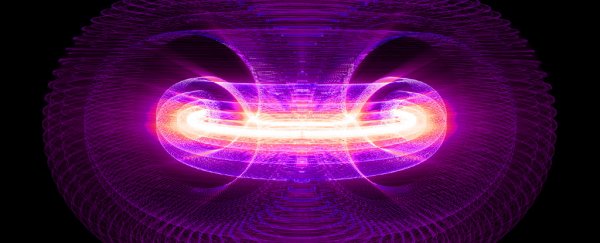Nuclear fusion describes the physics of two or more atomic nuclei merging to create larger elements – the type of process that occurs in our own Sun.
The reason this is an exciting prospect in energy production is because such an atomic merger can release large amounts of energy. If we can harness this energy release, humanity could potentially gain access to an abundant, inexhaustible source of largely sustainable power.
For now, such an achievement is still a way off, but researchers around the world are constantly advancing the field, delivering incremental improvements that are slowly getting us closer to this goal.
How does nuclear fusion work?
Atoms grow as protons collect into larger and larger groups, bound by the strong nuclear force. This attraction arises from interactions between their trios of constituent particles, called quarks.
Thanks to the Coulomb force – the attraction or repulsion force between particles due to their electric charge – protons tend to keep a good distance from one another - much too far for the nuclear force to grab hold.
Neutrons, on the other hand, have no charge so aren't repulsed, allowing them to move in relatively close to other nuclear particles with little effort. Thanks to subtle differences in a property called spin, neutrons and protons brought close together can stick to form a simple atomic nucleus.
In theory, a proton buddied with a neutron can bind with another proton and neutron partnership, with the neutrons acting as a kind of mediator. But getting multiple protons to huddle close enough for the strong force to take over is no easy feat. Even relatively simple mergers between two deuterium atoms (hydrogen consisting of a proton and a neutron) to make an atom of helium-3 requires the kind of pressure found in the cores of objects like our Sun.
For even bigger elements to emerge, like those the size of carbon, these pressurized furnaces would need to sustain temperatures of at least 100 million degrees Kelvin – six times hotter than the Sun's core.
Fusing nuclei into even heavier elements, on the scale of gold and uranium, requires a cosmic degree of power. Think of the kinds of forces found in colliding neutron stars, or certain supernovas.
How does nuclear fusion produce energy?
Fusion power production depends on differences in the amount of energy needed to hold together nuclear particles.
If you take an alpha particle – a pair of protons and a pair of neutrons clumped together – and weigh it, you'd get a mass of 4.00153 units. Weigh each atom individually, however, and the total sum would be 4.03188 units.
Going by the equation "energy = mass x square of the speed of light" (yep, that's E=mc2), the difference in the mass is also a difference in energy. Bound together, the collection of particles has less energy than when they're apart; therefore, when they merge, that spare energy is released out into the world.
Forged deep in the Sun, such energy slowly makes its way to the surface, where it is emitted in waves as electromagnetic radiation, or sunlight.
Here on Earth, physicists and engineers have been developing various devices that could help us to capture and use the energy released from nuclear fusion. When they succeed, you'll be sure to hear about it.
All Explainers are determined by fact checkers to be correct and relevant at the time of publishing. Text and images may be altered, removed, or added to as an editorial decision to keep information current.
